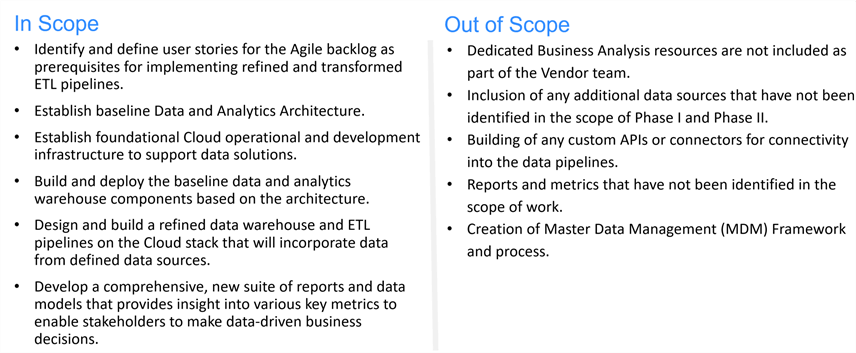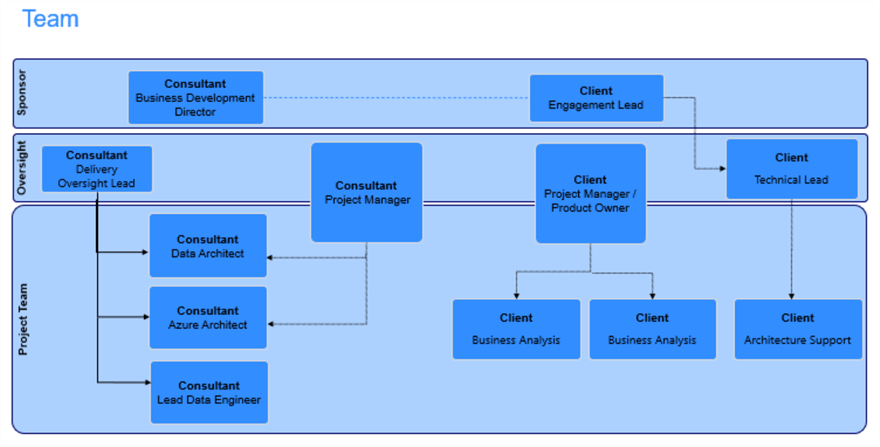By: Ron L'Esteve | Updated: 2022-08-16 | Comments | Related: 1 | 2 | 3 | 4 | 5 | 6 | > Cloud Strategy
Problem
Customers and stakeholders on the receiving end want their high-profile digital innovation and transformation projects and programs to deliver excellence and remain in a 'green' status throughout its lifecycle while exceeding delivery expectations related to customer satisfaction, scope, budgets, and other success criteria. A poorly scoped Statement of Work (SOW) that fails to accurately identify and track timelines, milestones, roadmaps, terms, conditions, assumptions, dependencies, costs, utilization, and more contributes to project failures.
Solution
Around 70% of transformational projects fail despite careful planning, the availability of expert certified skills, and significant investments of time and effort into these projects; it would be wise to meticulously initiate and plan the details of the project. After the 'Requirements Envisioning' phases have been completed successfully, the official implementation of the project can commence through an initiation phase comprised of careful planning, which would then seamlessly transition to delivery, monitoring and control, and eventually project closure. The following sections will detail the specifics around initiating, planning, monitoring, controlling, and closing out a successful transformational project to ensure that excellence is delivered at every step.
Since the requirements of many modern transformation projects are pretty fluid, they often follow an 'Agile' methodology which essentially requires an openness to change. Rather than focusing on the specifics of a methodology such as Scrum, Agile, or Waterfall, it would be a good idea to tailor the methodology and approach to the project, organization, and business needs. A successful project management methodology could be comprised of multiple methodologies. For our discussion, we will focus on the 'Agile' methodology since it accommodates fluid changes and requirements quite well in digital innovation and transformational projects. Transformational projects require a sense of urgency to demonstrate business value and ROI, a defined vision, short-term wins, a structure to support innovative change, and more. This will contribute to the project's success and the delivery of sustained differentiation to the end customers. This article will cover the fundamentals of project management excellence, focusing on project initiation and planning around scope, team, and risks.
The Initiation & Planning Phase
Within a transformational project's planning and initiation phase, the relevant scope of services, delivery methodology, project team roles, stakeholders, and personas will be identified. Additionally, the project's assumptions, dependencies, risks, and other intricacies will be defined and communicated to the various business and technical stakeholders. Careful planning will result in a Project Plan which captures the success criteria to achieve the defined goals. This includes estimating resources and capacity, the product backlog, and best practice approaches for communication, governance, monitoring, control, and training throughout the project. The following sections will capture the required details of the 'Initiation and Planning Phase'.
Scope
Defining what is within and out of bounds for the planned work scope is important for delivering excellence throughout the project. It is fair to mention that anything that is not in-scope shall be out-of-scope. This will help avoid scope creep and empower the need for effective change management processes. For example, the figure below shows how in and out of scope details might be documented for a Cloud Transformation project. Note that this captures the scope at the project level. Additional granular scopes also called 'goals', may need to be identified on a sprint-by-sprint basis as the project commences.

The anticipated deliverables covered in the 'Future State Design' part of the Envisioning Phase also begin to outline the expected scope of the project. This scope can be further detailed and split into the following list, which outlines the scope for implementation and documentation.
Implementation Scope Details
- An Audit, Balance, and Control (ABC) Framework to enable re-usability of data pipelines that source data from both Oracle and SQL Server databases.
- 1 Dynamic and parameterized ELT pipeline for ingesting a combination of 20 tables through 'Full' and 'Incremental' data ingestion patterns from source systems to the Bronze (Raw) zone in the Data Lake by using the ABC Framework.
- 1 Dynamic and parameterized ELT pipeline to cleanse, mask, and de-duplicate data based on encryption and defined cleansing logic and insert, update, and delete into the Silver (Cleansed) zone in the Data Lake by using custom cleansing logic.
- 5 ELT pipelines for aggregating and transforming data from the Silver zone into the Gold zone.
- 3 DevOps automated continuous integration deployment (CI / CD) processes for Data Transformation technology, Data ELT technology, and SQL database storage technology to deploy resources from DEV to UAT to PROD.
- 5 BI Reports consisting of dashboards and visualizations, which will be deployed onto a consumable web-based workspace.
Documentation Scope Details
- Document ETL pipelines and standards for re-usability by Data Engineers.
- Document DevOps CI and CD pipelines and standards for re-usability by DevOps Engineers.
- Document Infrastructure deployment and maintenance process and standards for Infrastructure Engineers and Architects.
- Document Reporting Dashboards and any SQL frameworks for Developers and Engineers.
Team
Having a well-defined project team is critical for the success of the project. A project team typically consists of 'Sponsors', 'Oversight Leadership', and the core 'Project Team'. Visually illustrating and communicating this Team structure early on will provide the necessary clarity for ensuring that the project includes all the right personas that position it to deliver excellence and achieve success at every step.
The following figure illustrates an example of the project team hierarchy. The actual names of the Consultant and Client would typically be replaced in the corresponding boxes of the hierarchy, right alongside the defined personas. While the project roles are being defined, the appropriate resource can be selected if they already exist and have been allocated to the project, else they will need to be interviewed and hired. Well-structured job descriptions and interview material will help leaders find the right resources for the project. For internal employees that have already been allocated to the project, it would always help them to skill up via role-based certification paths, ensuring that their capabilities are of the highest standard when the project begins.

Risks
Risks can find their way into some of the most meticulously planned projects. Since 'Agile' transformational projects have loosely defined initial requirements that are constantly evolving on a sprint-by-sprint basis, risks are unavoidable. During the project initiation phase, it would be wise to anticipate and identify potential risks and mitigation, management, and monitoring plans. For example, the following list begins to capture a few anticipated risks for a Cloud Transformation project.
- Potential Risk: Introduction of additional data sources, metrics, KPIs, reports, etc., that were overlooked in scoping and data source gathering sessions but are critical to an MVP.
- Mitigation Plan: An 'Agile' project may be more welcoming to changes in requirements along the way. Ensure that the contractual agreement specifies 'Change Request' plans and procedures clearly to speed up the process of facilitating the need for a change when one arises.
- Potential Risk: Complexity of Data Models may adversely impact project timelines through delays in delivering a Dimensional Data Model and completion of Reporting work.
- Mitigation Plan: Having a dedicated Business Analyst and Data Modeler that work closely together to deeply understand the business data and modeling approaches will significantly reduce the risk associated with delivering a data model on time.
- Potential Risk: Unavailability of required source data and/or access to relevant source systems may delay efforts to create necessary reporting metrics and KPIs.
- Mitigation Plan: Identifying the risks associated with the timely availability of the source systems during the Envisioning Phase will determine whether to reprioritize the expected deliverables of the project or the time frames for the availability of these sources. By identifying this as a risk early on, it will be on the project stakeholder's radar at the beginning to ensure that it will be mitigated before the commencement of the project.
- Potential Risk: A lack of base prerequisite infrastructure set up by the customer team may impact delivery timelines.
- Mitigation Plan: Ensure that your Centers of Excellence (CoE) has all the right tools and processes in place, such as Infrastructure as Code (IaC) and DevOps, to support and instantly deliver the required 'best practice adhering' infrastructure on time to prevent any delays to the project timelines.
Next Steps
- In part 5 of this series on Delivering Cloud Transformation Excellence, we will continue the discussion around Project Management Excellence by focusing efforts on a project's assumptions, dependencies, pricing models, backlog, and capacity.
- Read more about Project Initiation: How to Start Off a Project Right (projectmanager.com)
- Read more about A Guide to Digital Transformation for Project Managers | Toptal
- Read more about Project Planning: What is it and Steps to Create a Plan | SearchCIO (techtarget.com)
- Read more about How to Create a Project Plan in 5 Simple Steps | TeamGantt
About the author
 Ron L'Esteve is a trusted information technology thought leader and professional Author residing in Illinois. He brings over 20 years of IT experience and is well-known for his impactful books and article publications on Data & AI Architecture, Engineering, and Cloud Leadership. Ron completed his Masterís in Business Administration and Finance from Loyola University in Chicago. Ron brings deep tec
Ron L'Esteve is a trusted information technology thought leader and professional Author residing in Illinois. He brings over 20 years of IT experience and is well-known for his impactful books and article publications on Data & AI Architecture, Engineering, and Cloud Leadership. Ron completed his Masterís in Business Administration and Finance from Loyola University in Chicago. Ron brings deep tecThis author pledges the content of this article is based on professional experience and not AI generated.
View all my tips
Article Last Updated: 2022-08-16






